
Maritime history of Europe
Encyclopedia
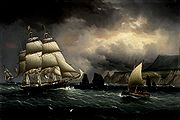
Eurasia
Eurasia is a continent or supercontinent comprising the traditional continents of Europe and Asia ; covering about 52,990,000 km2 or about 10.6% of the Earth's surface located primarily in the eastern and northern hemispheres...
in areas concerning shipping
Shipping
Shipping has multiple meanings. It can be a physical process of transporting commodities and merchandise goods and cargo, by land, air, and sea. It also can describe the movement of objects by ship.Land or "ground" shipping can be by train or by truck...
and shipbuilding
Shipbuilding
Shipbuilding is the construction of ships and floating vessels. It normally takes place in a specialized facility known as a shipyard. Shipbuilders, also called shipwrights, follow a specialized occupation that traces its roots to before recorded history.Shipbuilding and ship repairs, both...
, shipwrecks, naval battle
Naval battle
A naval battle is a battle fought using boats, ships or other waterborne vessels. Most naval battles have occurred at sea, but a few have taken place on lakes or rivers. The earliest recorded naval battle took place in 1210 BC near Cyprus...
s, and military
Military
A military is an organization authorized by its greater society to use lethal force, usually including use of weapons, in defending its country by combating actual or perceived threats. The military may have additional functions of use to its greater society, such as advancing a political agenda e.g...
installations and lighthouses constructed to protect or aid navigation
Navigation
Navigation is the process of monitoring and controlling the movement of a craft or vehicle from one place to another. It is also the term of art used for the specialized knowledge used by navigators to perform navigation tasks...
and the development of Europe
Europe
Europe is, by convention, one of the world's seven continents. Comprising the westernmost peninsula of Eurasia, Europe is generally 'divided' from Asia to its east by the watershed divides of the Ural and Caucasus Mountains, the Ural River, the Caspian and Black Seas, and the waterways connecting...
. Although Europe is the world's second-smallest continent
Continent
A continent is one of several very large landmasses on Earth. They are generally identified by convention rather than any strict criteria, with seven regions commonly regarded as continents—they are : Asia, Africa, North America, South America, Antarctica, Europe, and Australia.Plate tectonics is...
in terms of area, is has a very long coastline, and has arguably been influenced more by its maritime history
Maritime history
Maritime history is the study of human activity at sea. It covers a broad thematic element of history that often uses a global approach, although national and regional histories remain predominant...
than any other continent.
Europe is uniquely situated between several navigable sea
Sea
A sea generally refers to a large body of salt water, but the term is used in other contexts as well. Most commonly, it means a large expanse of saline water connected with an ocean, and is commonly used as a synonym for ocean...
s and intersected by navigable river
River
A river is a natural watercourse, usually freshwater, flowing towards an ocean, a lake, a sea, or another river. In a few cases, a river simply flows into the ground or dries up completely before reaching another body of water. Small rivers may also be called by several other names, including...
s running into them in a way which greatly facilitated the influence of maritime traffic and commerce. Great battles have been fought in the seas off of Europe that changed the course of history forever, including the Battle of Salamis
Battle of Salamis
The Battle of Salamis was fought between an Alliance of Greek city-states and the Persian Empire in September 480 BCE, in the straits between the mainland and Salamis, an island in the Saronic Gulf near Athens...
in the Mediterranean, the Battle of Gravelines at the eastern end of the English Channel in the summer of 1588, in which the “Invincible” Spanish Armada
Spanish Armada
This article refers to the Battle of Gravelines, for the modern navy of Spain, see Spanish NavyThe Spanish Armada was the Spanish fleet that sailed against England under the command of the Duke of Medina Sidonia in 1588, with the intention of overthrowing Elizabeth I of England to stop English...
was defeated, the Battle of Jutland
Battle of Jutland
The Battle of Jutland was a naval battle between the British Royal Navy's Grand Fleet and the Imperial German Navy's High Seas Fleet during the First World War. The battle was fought on 31 May and 1 June 1916 in the North Sea near Jutland, Denmark. It was the largest naval battle and the only...
in World War I
World War I
World War I , which was predominantly called the World War or the Great War from its occurrence until 1939, and the First World War or World War I thereafter, was a major war centred in Europe that began on 28 July 1914 and lasted until 11 November 1918...
, and World War II
World War II
World War II, or the Second World War , was a global conflict lasting from 1939 to 1945, involving most of the world's nations—including all of the great powers—eventually forming two opposing military alliances: the Allies and the Axis...
’s U-boat
U-boat
U-boat is the anglicized version of the German word U-Boot , itself an abbreviation of Unterseeboot , and refers to military submarines operated by Germany, particularly in World War I and World War II...
war.

Ancient times
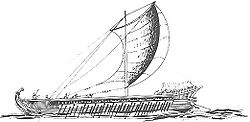
Egyptians
Egyptians are nation an ethnic group made up of Mediterranean North Africans, the indigenous people of Egypt.Egyptian identity is closely tied to geography. The population of Egypt is concentrated in the lower Nile Valley, the small strip of cultivable land stretching from the First Cataract to...
built the first sea-going ships, the Minoan
Minoan civilization
The Minoan civilization was a Bronze Age civilization that arose on the island of Crete and flourished from approximately the 27th century BC to the 15th century BC. It was rediscovered at the beginning of the 20th century through the work of the British archaeologist Arthur Evans...
s of Crete
Crete
Crete is the largest and most populous of the Greek islands, the fifth largest island in the Mediterranean Sea, and one of the thirteen administrative regions of Greece. It forms a significant part of the economy and cultural heritage of Greece while retaining its own local cultural traits...
were the first great seafarers of the Mediterranean Sea
Mediterranean Sea
The Mediterranean Sea is a sea connected to the Atlantic Ocean surrounded by the Mediterranean region and almost completely enclosed by land: on the north by Anatolia and Europe, on the south by North Africa, and on the east by the Levant...
. Little is known of their ships, but they reportedly traded pottery as far west as Sicily
Sicily
Sicily is a region of Italy, and is the largest island in the Mediterranean Sea. Along with the surrounding minor islands, it constitutes an autonomous region of Italy, the Regione Autonoma Siciliana Sicily has a rich and unique culture, especially with regard to the arts, music, literature,...
, and their King Minos conquered the islands of the Aegean
Aegean Sea
The Aegean Sea[p] is an elongated embayment of the Mediterranean Sea located between the southern Balkan and Anatolian peninsulas, i.e., between the mainlands of Greece and Turkey. In the north, it is connected to the Marmara Sea and Black Sea by the Dardanelles and Bosporus...
(according to Thucydides
Thucydides
Thucydides was a Greek historian and author from Alimos. His History of the Peloponnesian War recounts the 5th century BC war between Sparta and Athens to the year 411 BC...
).
The Battle of Salamis
Battle of Salamis
The Battle of Salamis was fought between an Alliance of Greek city-states and the Persian Empire in September 480 BCE, in the straits between the mainland and Salamis, an island in the Saronic Gulf near Athens...
occurred in September 480 BC, when the Greeks, with 371 triremes and ‘’pentekonters’’, routed a Persian force of over 1,200 ships under the command of King Xerxes
Xerxes I of Persia
Xerxes I of Persia , Ḫšayāršā, ), also known as Xerxes the Great, was the fifth king of kings of the Achaemenid Empire.-Youth and rise to power:...
. Persian losses amounted to some 200 ships and 20,000 men. The battle was fought near Athens, Greece, in the straits between Piraeus and Salamis
Salamis Island
Salamis , is the largest Greek island in the Saronic Gulf, about 1 nautical mile off-coast from Piraeus and about 16 km west of Athens. The chief city, Salamina , lies in the west-facing core of the crescent on Salamis Bay, which opens into the Saronic Gulf...
.
Maritime history of the Roman Empire
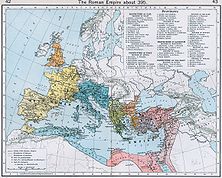
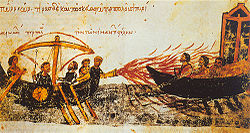
Roman Empire
The Roman Empire was the post-Republican period of the ancient Roman civilization, characterised by an autocratic form of government and large territorial holdings in Europe and around the Mediterranean....
. The empires’ struggle with Carthage
Carthage
Carthage , implying it was a 'new Tyre') is a major urban centre that has existed for nearly 3,000 years on the Gulf of Tunis, developing from a Phoenician colony of the 1st millennium BC...
inspired them to build and to fight in war galleys, but the galleys did not have much cargo space, so “round ships” were constructed for trade, especially with Egypt. Many of these ships reached 200 feet (61 m) in length and were capable of carrying over a thousand tons of cargo. These ships used sail power alone to haul commodities in the mediterranean sea. The volume of trade that the roman merchant fleet carried was larger than any other until the industrial revolution
Industrial Revolution
The Industrial Revolution was a period from the 18th to the 19th century where major changes in agriculture, manufacturing, mining, transportation, and technology had a profound effect on the social, economic and cultural conditions of the times...
. We know quite a bit about these round ships, since Romans, like Egyptians and Greeks, left records in stone, sometimes even on a sarcophagus
Sarcophagus
A sarcophagus is a funeral receptacle for a corpse, most commonly carved or cut from stone. The word "sarcophagus" comes from the Greek σαρξ sarx meaning "flesh", and φαγειν phagein meaning "to eat", hence sarkophagus means "flesh-eating"; from the phrase lithos sarkophagos...
.
There were many shipwrecks of Roman vessels, which can be explained by the very large number of trading vessels during Roman times since the volume of sea trade in the mediterranean reached a quantity to be only equaled in the 19th century. This greatly increased the number of shipwrecks.
The western Mediterranean came under the control of the barbarians, after their invasion
Invasion
An invasion is a military offensive consisting of all, or large parts of the armed forces of one geopolitical entity aggressively entering territory controlled by another such entity, generally with the objective of either conquering, liberating or re-establishing control or authority over a...
split the Empire in two, while Byzantium
Byzantine Empire
The Byzantine Empire was the Eastern Roman Empire during the periods of Late Antiquity and the Middle Ages, centred on the capital of Constantinople. Known simply as the Roman Empire or Romania to its inhabitants and neighbours, the Empire was the direct continuation of the Ancient Roman State...
dominated the eastern half of the sea. The eastern empire lasted until 1453, such was the efficiency of the Byzantine navy
Navy
A navy is the branch of a nation's armed forces principally designated for naval and amphibious warfare; namely, lake- or ocean-borne combat operations and related functions...
, with its fleets armed with Byzantine fire (or Greek fire
Greek fire
Greek fire was an incendiary weapon used by the Byzantine Empire. The Byzantines typically used it in naval battles to great effect as it could continue burning while floating on water....
), a mixture of naphtha
Naphtha
Naphtha normally refers to a number of different flammable liquid mixtures of hydrocarbons, i.e., a component of natural gas condensate or a distillation product from petroleum, coal tar or peat boiling in a certain range and containing certain hydrocarbons. It is a broad term covering among the...
oil
Oil
An oil is any substance that is liquid at ambient temperatures and does not mix with water but may mix with other oils and organic solvents. This general definition includes vegetable oils, volatile essential oils, petrochemical oils, and synthetic oils....
and saltpetre
Potassium nitrate
Potassium nitrate is a chemical compound with the formula KNO3. It is an ionic salt of potassium ions K+ and nitrate ions NO3−.It occurs as a mineral niter and is a natural solid source of nitrogen. Its common names include saltpetre , from medieval Latin sal petræ: "stone salt" or possibly "Salt...
, fired through tubes in the bows of the ship. Enemy ships were often afraid to get too close to the Byzantine fleet, since the liquid fire gave the Byzantines a considerable advantage.
The Viking Age

British Isles
The British Isles are a group of islands off the northwest coast of continental Europe that include the islands of Great Britain and Ireland and over six thousand smaller isles. There are two sovereign states located on the islands: the United Kingdom of Great Britain and Northern Ireland and...
, Scandinavia
Scandinavia
Scandinavia is a cultural, historical and ethno-linguistic region in northern Europe that includes the three kingdoms of Denmark, Norway and Sweden, characterized by their common ethno-cultural heritage and language. Modern Norway and Sweden proper are situated on the Scandinavian Peninsula,...
, as far south as Cádiz
Cádiz
Cadiz is a city and port in southwestern Spain. It is the capital of the homonymous province, one of eight which make up the autonomous community of Andalusia....
, Spain
Al-Andalus
Al-Andalus was the Arabic name given to a nation and territorial region also commonly referred to as Moorish Iberia. The name describes parts of the Iberian Peninsula and Septimania governed by Muslims , at various times in the period between 711 and 1492, although the territorial boundaries...
and even attacked Pisa
Pisa
Pisa is a city in Tuscany, Central Italy, on the right bank of the mouth of the River Arno on the Tyrrhenian Sea. It is the capital city of the Province of Pisa...
, Italy
Italy
Italy , officially the Italian Republic languages]] under the European Charter for Regional or Minority Languages. In each of these, Italy's official name is as follows:;;;;;;;;), is a unitary parliamentary republic in South-Central Europe. To the north it borders France, Switzerland, Austria and...
in 860. They sailed up the Seine River in France
France
The French Republic , The French Republic , The French Republic , (commonly known as France , is a unitary semi-presidential republic in Western Europe with several overseas territories and islands located on other continents and in the Indian, Pacific, and Atlantic oceans. Metropolitan France...
, settled Normandy (which derives its name from the Norsemen), and settled Dublin after invading Ireland
Ireland
Ireland is an island to the northwest of continental Europe. It is the third-largest island in Europe and the twentieth-largest island on Earth...
. Varangians
Varangians
The Varangians or Varyags , sometimes referred to as Variagians, were people from the Baltic region, most often associated with Vikings, who from the 9th to 11th centuries ventured eastwards and southwards along the rivers of Eastern Europe, through what is now Russia, Belarus and Ukraine.According...
were more concerned with trading than raiding, and sailed along Russian rivers and opened commercial routes to the Caspian Sea
Caspian Sea
The Caspian Sea is the largest enclosed body of water on Earth by area, variously classed as the world's largest lake or a full-fledged sea. The sea has a surface area of and a volume of...
as well as the Black Sea
Black Sea
The Black Sea is bounded by Europe, Anatolia and the Caucasus and is ultimately connected to the Atlantic Ocean via the Mediterranean and the Aegean seas and various straits. The Bosphorus strait connects it to the Sea of Marmara, and the strait of the Dardanelles connects that sea to the Aegean...
.
The Vikings were the best naval architect
Naval architecture
Naval architecture is an engineering discipline dealing with the design, construction, maintenance and operation of marine vessels and structures. Naval architecture involves basic and applied research, design, development, design evaluation and calculations during all stages of the life of a...
s of their day, and the Viking longship was both large and versatile. A longship found at Oseberg, Norway
Norway
Norway , officially the Kingdom of Norway, is a Nordic unitary constitutional monarchy whose territory comprises the western portion of the Scandinavian Peninsula, Jan Mayen, and the Arctic archipelago of Svalbard and Bouvet Island. Norway has a total area of and a population of about 4.9 million...
, was 76 feet (23.2 m), 6 inches in length (more than 23 meters), more than 17 feet (5.2 m) wide, and had a draft of only 3 foot (0.9144 m). The shallow draft enabled them to navigate far inland in shallow rivers. Later on during the Viking period some of the ships were reported to be over 100 feet (30.5 m) long.
“From the fury of the Norsemen, good Lord, deliver us,” has entered apocryphal knowledge as a common prayer among the people of western Europe during the period of the Norse raiders from the late 8th century to the 11th century. According to the website Viking Answer Lady
http://web.archive.org/web/20101201231124/http://vikinganswerlady.com/vikfury.shtml Viking Answer Lady. Archived copy retrieved December 01, 2010.
,
which in turn cites Magnus Magnusson's Vikings!
Magnus Magnusson. Vikings! New York: E.P. Dutton. 1980. ISBN 0525228926. p.61.
as its reference,
No 9th century text has ever been discovered containing these words, although numerous medieval litanies and prayers contain general formulas for deliverance against unnamed enemies. The closest documentable phrase is a single sentence, taken from an antiphony for churches dedicated to St. VaastVedastSaint Vedast or Vedastus, also known as Saint Vaast or Saint Waast and Saint Gaston in French, Saint Vedast or Vedastus, also known as Saint Vaast (in Flemish, Norman, and Picard) or Saint Waast (also in Picard and Walloon) and Saint Gaston in French, Saint Vedast or Vedastus, also known as Saint...
or St. MedardMedardusSaint Medardus was the Bishop of Vermandois who removed the seat of the diocese to Noyon....
: Summa pia gratia nostra conservando corpora et cutodita, de gente fera Normannica nos libera, quae nostra vastat, Deus, regna, ”Our supreme and holy Grace, protecting us and ours, deliver us, God, from the savage race of Northmen which lays waste our realms”.
The Hanseatic League

Hanseatic League
The Hanseatic League was an economic alliance of trading cities and their merchant guilds that dominated trade along the coast of Northern Europe...
was an alliance of trading cities that established and maintained a trade monopoly over the Baltic Sea
Baltic Sea
The Baltic Sea is a brackish mediterranean sea located in Northern Europe, from 53°N to 66°N latitude and from 20°E to 26°E longitude. It is bounded by the Scandinavian Peninsula, the mainland of Europe, and the Danish islands. It drains into the Kattegat by way of the Øresund, the Great Belt and...
and most of Northern Europe for a time in the later Middle Ages
Middle Ages
The Middle Ages is a periodization of European history from the 5th century to the 15th century. The Middle Ages follows the fall of the Western Roman Empire in 476 and precedes the Early Modern Era. It is the middle period of a three-period division of Western history: Classic, Medieval and Modern...
and the Early Modern period, between the 13th and 17th centuries.
Although trading alliances in the region were forming as early as 1157, the town of Lübeck
Lübeck
The Hanseatic City of Lübeck is the second-largest city in Schleswig-Holstein, in northern Germany, and one of the major ports of Germany. It was for several centuries the "capital" of the Hanseatic League and, because of its Brick Gothic architectural heritage, is listed by UNESCO as a World...
did not form an alliance with Hamburg
Hamburg
-History:The first historic name for the city was, according to Claudius Ptolemy's reports, Treva.But the city takes its modern name, Hamburg, from the first permanent building on the site, a castle whose construction was ordered by the Emperor Charlemagne in AD 808...
(which controlled access to salt routes from Lüneburg
Lüneburg
Lüneburg is a town in the German state of Lower Saxony. It is located about southeast of fellow Hanseatic city Hamburg. It is part of the Hamburg Metropolitan Region, and one of Hamburg's inner suburbs...
), until 1241.
Trade was carried on chiefly by sea in order to escape tolls and political barriers, and at the end of the 15th century the Hanseatic League controlled some 60,000 tons of shipping. Although compasses were commonly being used in the Mediterranean during this period, the captains of Hanseatic vessels seemed slow to adopt the new technology, which put them in greater danger of wrecking. They also had to deal with pirates.
The League’s power waned when the great herring
Herring
Herring is an oily fish of the genus Clupea, found in the shallow, temperate waters of the North Pacific and the North Atlantic oceans, including the Baltic Sea. Three species of Clupea are recognized. The main taxa, the Atlantic herring and the Pacific herring may each be divided into subspecies...
shoal
Shoal
Shoal, shoals or shoaling may mean:* Shoal, a sandbank or reef creating shallow water, especially where it forms a hazard to shipping* Shoal draught , of a boat with shallow draught which can pass over some shoals: see Draft...
s disappeared in the Baltic, possibly because of a decline in the sea’s salinity. During the late 16th century and early 17th century, the League fell apart, as it was unable to deal with its own internal struggles, the rise of Swedish, Dutch and English merchants, and the social and political changes that accompanied the Reformation
Protestant Reformation
The Protestant Reformation was a 16th-century split within Western Christianity initiated by Martin Luther, John Calvin and other early Protestants. The efforts of the self-described "reformers", who objected to the doctrines, rituals and ecclesiastical structure of the Roman Catholic Church, led...
.
Although a tight-fisted monopoly
Monopoly
A monopoly exists when a specific person or enterprise is the only supplier of a particular commodity...
, the League’s need for more cargo space led to new designs in shipbuilding
Shipbuilding
Shipbuilding is the construction of ships and floating vessels. It normally takes place in a specialized facility known as a shipyard. Shipbuilders, also called shipwrights, follow a specialized occupation that traces its roots to before recorded history.Shipbuilding and ship repairs, both...
, and its free association of about 160 towns and villages was a historically unique economic alliance that showed the benefits of well-regulated commerce
Commerce
While business refers to the value-creating activities of an organization for profit, commerce means the whole system of an economy that constitutes an environment for business. The system includes legal, economic, political, social, cultural, and technological systems that are in operation in any...
.
Republic of Venice
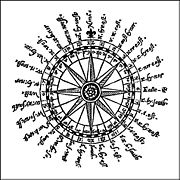
Constantinople
Constantinople was the capital of the Roman, Eastern Roman, Byzantine, Latin, and Ottoman Empires. Throughout most of the Middle Ages, Constantinople was Europe's largest and wealthiest city.-Names:...
(now Istanbul
Istanbul
Istanbul , historically known as Byzantium and Constantinople , is the largest city of Turkey. Istanbul metropolitan province had 13.26 million people living in it as of December, 2010, which is 18% of Turkey's population and the 3rd largest metropolitan area in Europe after London and...
), and to Alexandria
Alexandria
Alexandria is the second-largest city of Egypt, with a population of 4.1 million, extending about along the coast of the Mediterranean Sea in the north central part of the country; it is also the largest city lying directly on the Mediterranean coast. It is Egypt's largest seaport, serving...
in Egypt
Egypt
Egypt , officially the Arab Republic of Egypt, Arabic: , is a country mainly in North Africa, with the Sinai Peninsula forming a land bridge in Southwest Asia. Egypt is thus a transcontinental country, and a major power in Africa, the Mediterranean Basin, the Middle East and the Muslim world...
, and returned to Venice carrying luxury items. A sea route to the Indies discovered by Portugal signaled an end to the glory days of Venice's merchant galleys and spice trade, but the war galleys (or fighting galleys) lived on. The war galleys were mostly manned by prisoners of war or convicts, who were chained to benches, usually three to six per oar.
More than 3,000 Venetian merchant ships were in operation by the year 1450. The trading empire of the Republic of Venice lasted longer than any other in history, and even merchants vessels were required to carry weapons and passengers were expected to be armed and ready to fight. From the beginning of the 13th century until the end of the 18th century, the Republic ruled the Adriatic, the Aegean and the Black Sea
Black Sea
The Black Sea is bounded by Europe, Anatolia and the Caucasus and is ultimately connected to the Atlantic Ocean via the Mediterranean and the Aegean seas and various straits. The Bosphorus strait connects it to the Sea of Marmara, and the strait of the Dardanelles connects that sea to the Aegean...
s. The Republic of Genoa was Venice’s main rival, and many wars were fought between them. In 1298 the Genoese destroyed the Venetian fleet at Curzola, but were themselves defeated in 1354 at Sapienza in Greece.
The European Age Of Discovery 1400 - 1600
The Age of DiscoveryAge of Discovery
The Age of Discovery, also known as the Age of Exploration and the Great Navigations , was a period in history starting in the early 15th century and continuing into the early 17th century during which Europeans engaged in intensive exploration of the world, establishing direct contacts with...
started with the Portuguese navigators. Prince Henry the Navigator would start a maritime school in Portugal
Portugal
Portugal , officially the Portuguese Republic is a country situated in southwestern Europe on the Iberian Peninsula. Portugal is the westernmost country of Europe, and is bordered by the Atlantic Ocean to the West and South and by Spain to the North and East. The Atlantic archipelagos of the...
. The resulting technical and scientific discoveries led to Portugal developing the most advanced ships / caravels that for the first time in history would make truly global maritime navigation possible. It led to the Portuguese Kingdom discovering and mapping most of the Globe. The route to India
India
India , officially the Republic of India , is a country in South Asia. It is the seventh-largest country by geographical area, the second-most populous country with over 1.2 billion people, and the most populous democracy in the world...
via the Cape of Good Hope
Cape of Good Hope
The Cape of Good Hope is a rocky headland on the Atlantic coast of the Cape Peninsula, South Africa.There is a misconception that the Cape of Good Hope is the southern tip of Africa, because it was once believed to be the dividing point between the Atlantic and Indian Oceans. In fact, the...
was discovered in two phases. Initially Bartolomeu Dias
Bartolomeu Dias
Bartolomeu Dias , a nobleman of the Portuguese royal household, was a Portuguese explorer who sailed around the southernmost tip of Africa in 1488, the first European known to have done so.-Purposes of the Dias expedition:...
left Portugal and rounded the Cape of Good Hope. The Second phase would take Vasco da Gama
Vasco da Gama
Vasco da Gama, 1st Count of Vidigueira was a Portuguese explorer, one of the most successful in the Age of Discovery and the commander of the first ships to sail directly from Europe to India...
around the southern tip of Africa
Africa
Africa is the world's second largest and second most populous continent, after Asia. At about 30.2 million km² including adjacent islands, it covers 6% of the Earth's total surface area and 20.4% of the total land area...
and on to India and the East. It was the first time in history that humans had navigated from Europe around Africa to Asia
Asia
Asia is the world's largest and most populous continent, located primarily in the eastern and northern hemispheres. It covers 8.7% of the Earth's total surface area and with approximately 3.879 billion people, it hosts 60% of the world's current human population...
. It also led to the discovery of Brazil
Brazil
Brazil , officially the Federative Republic of Brazil , is the largest country in South America. It is the world's fifth largest country, both by geographical area and by population with over 192 million people...
and South America
South America
South America is a continent situated in the Western Hemisphere, mostly in the Southern Hemisphere, with a relatively small portion in the Northern Hemisphere. The continent is also considered a subcontinent of the Americas. It is bordered on the west by the Pacific Ocean and on the north and east...
. It would also be a Portuguese nobleman, Ferdinand Magellan
Ferdinand Magellan
Ferdinand Magellan was a Portuguese explorer. He was born in Sabrosa, in northern Portugal, and served King Charles I of Spain in search of a westward route to the "Spice Islands" ....
(although at the time lending his services to the Spanish crown) that would be the first man to sail around the world.
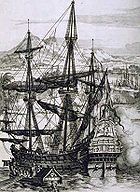
Christopher Columbus
Christopher Columbus was an explorer, colonizer, and navigator, born in the Republic of Genoa, in northwestern Italy. Under the auspices of the Catholic Monarchs of Spain, he completed four voyages across the Atlantic Ocean that led to general European awareness of the American continents in the...
set sail in the Santa Maria on what is probably history’s greatest voyage of discovery on August 3, 1492. Leaving from the town of Palos
Palos
Palos may refer to:Places*Palos de la Frontera, a municipality in Spain*Cape Palos, cape on the Mediterranean coast of Spain*Palos Township, Cook County, Illinois*Palos Heights, Illinois*Paloş , a village in Caţa Commune, Braşov County, RomaniaEvents...
, in southern Spain, Columbus headed west. After a brief stop in the Canary Islands
Canary Islands
The Canary Islands , also known as the Canaries , is a Spanish archipelago located just off the northwest coast of mainland Africa, 100 km west of the border between Morocco and the Western Sahara. The Canaries are a Spanish autonomous community and an outermost region of the European Union...
for provisions and repairs, he set out for Asia. He reached San Salvador first, it is believed, (easternmost of the Bahamas) in October, and then sailed past Cuba
Cuba
The Republic of Cuba is an island nation in the Caribbean. The nation of Cuba consists of the main island of Cuba, the Isla de la Juventud, and several archipelagos. Havana is the largest city in Cuba and the country's capital. Santiago de Cuba is the second largest city...
and Hispaniola
Hispaniola
Hispaniola is a major island in the Caribbean, containing the two sovereign states of the Dominican Republic and Haiti. The island is located between the islands of Cuba to the west and Puerto Rico to the east, within the hurricane belt...
, still searching for Asia. He returned home in 1493 to a hero's welcome, and within six months had 1,500 men and 17 vessels at his command.
The year 1571 saw the last great battle between galleys, when more than 400 Turkish
Ottoman Empire
The Ottoman EmpireIt was usually referred to as the "Ottoman Empire", the "Turkish Empire", the "Ottoman Caliphate" or more commonly "Turkey" by its contemporaries...
and Christian
Christian
A Christian is a person who adheres to Christianity, an Abrahamic, monotheistic religion based on the life and teachings of Jesus of Nazareth as recorded in the Canonical gospels and the letters of the New Testament...
vessels engaged each other on the Gulf of Patras
Gulf of Patras
The Gulf of Patras is a branch of the Ionian Sea. On the east, it is closed by the Strait of Rion between capes Rio, Greece and Antirrio, near the Rio-Antirio bridge. On the west, it is bounded by a line from Oxeia island to Cape Araxos...
. The Battle of Lepanto
Battle of Lepanto (1571)
The Battle of Lepanto took place on 7 October 1571 when a fleet of the Holy League, a coalition of Catholic maritime states, decisively defeated the main fleet of the Ottoman Empire in five hours of fighting on the northern edge of the Gulf of Patras, off western Greece...
as it was called, saw some 38,000 men perish. Miguel de Cervantes
Miguel de Cervantes
Miguel de Cervantes Saavedra was a Spanish novelist, poet, and playwright. His magnum opus, Don Quixote, considered the first modern novel, is a classic of Western literature, and is regarded amongst the best works of fiction ever written...
, author of Don Quixote, was wounded during the battle.
In April 1587, Sir Francis Drake burned 37 Spanish ships in the harbor at Cádiz
Cádiz
Cadiz is a city and port in southwestern Spain. It is the capital of the homonymous province, one of eight which make up the autonomous community of Andalusia....
, in southern Spain.
The publication of Jan Huygen van Linschoten's book Voyages provided a significant turning point in Europe's maritime history. Before the publication of this book, knowledge of the sea route to the Far East had been well guarded by the Portuguese for over a century. Voyages was published in several languages, including English and German (published in 1598), Latin (1599), and French (1610). Widely read by Europeans, the original Dutch edition and the French translation had second editions published.
Once knowledge of the sea route became available to all Europeans, more ships headed to East Asia. A Dutch fleet embarked on a voyage to India using Linschoten’s charts in 1595. (The Dutch version of his book was published in 1596, but his sea charts had been published the previous year). The publication of the nautical maps enabled the Dutch and British East India companies to break the trade monopoly Portugal held with the East Indies. Protestant Europe was ushered into the age of discovery in large part thanks to his work.
European innovations
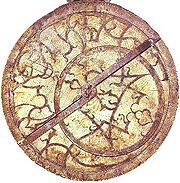
During this time period, Europeans made remarkable inroads in maritime innovation
Innovation
Innovation is the creation of better or more effective products, processes, technologies, or ideas that are accepted by markets, governments, and society...
s. These innovations enabled them to expand overseas and set up colonies, most notably during the sixteenth and seventeenth centuries.
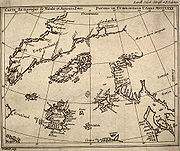
Sail
A sail is any type of surface intended to move a vessel, vehicle or rotor by being placed in a wind—in essence a propulsion wing. Sails are used in sailing.-History of sails:...
arrangements for ships, skeleton-based shipbuilding, the Western “galea” (at the end of the 11th century), sophisticated navigational instruments, and detailed chart
Chart
A chart is a graphical representation of data, in which "the data is represented by symbols, such as bars in a bar chart, lines in a line chart, or slices in a pie chart"...
s. After Isaac Newton published the Principia, navigation was transformed. Starting in 1670, the entire world was measured using essentially modern latitude instruments and the best available clocks. In 1730 the sextant was invented and navigators rapidly replaced their astrolabe
Astrolabe
An astrolabe is an elaborate inclinometer, historically used by astronomers, navigators, and astrologers. Its many uses include locating and predicting the positions of the Sun, Moon, planets, and stars, determining local time given local latitude and longitude, surveying, triangulation, and to...
s.
Barbary pirates
For several centuries, from about the time of the CrusadesCrusades
The Crusades were a series of religious wars, blessed by the Pope and the Catholic Church with the main goal of restoring Christian access to the holy places in and near Jerusalem...
until the early 19th century, the Barbary pirates of northern Africa
Africa
Africa is the world's second largest and second most populous continent, after Asia. At about 30.2 million km² including adjacent islands, it covers 6% of the Earth's total surface area and 20.4% of the total land area...
preyed on ships in the western Mediterranean Sea. In 1816, the Royal Navy, with assistance from the Dutch, destroyed the Barbary fleet in the port of Algiers
Algiers
' is the capital and largest city of Algeria. According to the 1998 census, the population of the city proper was 1,519,570 and that of the urban agglomeration was 2,135,630. In 2009, the population was about 3,500,000...
. The best-known pirate of this period may have been Barbarossa, the nickname of Khair ad Din, an Ottoman
Ottoman Turks
The Ottoman Turks were the Turkish-speaking population of the Ottoman Empire who formed the base of the state's military and ruling classes. Reliable information about the early history of Ottoman Turks is scarce, but they take their Turkish name, Osmanlı , from the house of Osman I The Ottoman...
-Turkish admiral
Admiral
Admiral is the rank, or part of the name of the ranks, of the highest naval officers. It is usually considered a full admiral and above vice admiral and below admiral of the fleet . It is usually abbreviated to "Adm" or "ADM"...
and privateer
Privateer
A privateer is a private person or ship authorized by a government by letters of marque to attack foreign shipping during wartime. Privateering was a way of mobilizing armed ships and sailors without having to spend public money or commit naval officers...
who was born on the island of Lesbos
Lesbos Island
Lesbos is a Greek island located in the northeastern Aegean Sea. It has an area of with 320 kilometres of coastline, making it the third largest Greek island. It is separated from Turkey by the narrow Mytilini Strait....
, (present-day Greece
Greece
Greece , officially the Hellenic Republic , and historically Hellas or the Republic of Greece in English, is a country in southeastern Europe....
), and lived from about 1475-1546.
Siege of Gibraltar and the Battle of Trafalgar
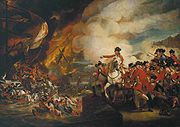
Garrison
Garrison is the collective term for a body of troops stationed in a particular location, originally to guard it, but now often simply using it as a home base....
survived all attacks, including an assault on September 13, 1782 that included 48 ships and 450 cannon
Cannon
A cannon is any piece of artillery that uses gunpowder or other usually explosive-based propellents to launch a projectile. Cannon vary in caliber, range, mobility, rate of fire, angle of fire, and firepower; different forms of cannon combine and balance these attributes in varying degrees,...
. In October 1805, the Battle of Trafalgar
Battle of Trafalgar
The Battle of Trafalgar was a sea battle fought between the British Royal Navy and the combined fleets of the French Navy and Spanish Navy, during the War of the Third Coalition of the Napoleonic Wars ....
took place, which involved 60 vessels, 27 British, and 33 French and Spanish. The British did not lose a single ship, and destroyed the enemy fleet, but Admiral Lord Nelson died in the battle. It was the most significant naval battle of the beginning of the 19th century, and confirmed the British Navy’s supremacy of the time.
Lighthouses

Meloria
Meloria is a rocky islet, surrounded by a shoal, off the Tuscan coast, in the Ligurian Sea, almost opposite Livorno. It was the scene of two naval battles of the Middle Ages....
is often considered the first lighthouse in Europe since Roman times. Meloria, a rocky islet off the Tuscan coast in the Tyrrhenian Sea
Tyrrhenian Sea
The Tyrrhenian Sea is part of the Mediterranean Sea off the western coast of Italy.-Geography:The sea is bounded by Corsica and Sardinia , Tuscany, Lazio, Campania, Basilicata and Calabria and Sicily ....
, was the location of two medieval naval battles. The Tower of Hercules
Tower of Hercules
The Tower of Hercules is an ancient Roman lighthouse on a peninsula about from the centre of A Coruña, Galicia, in north-western Spain. Until the 20th century, the tower itself was known as the "Farum Brigantium". The Latin word farum is derived from the Greek pharos for the Lighthouse of...
(Torre de Hércules), in northwestern Spain, is almost 1,900 years old. The ancient Roman lighthouse stands near A Coruña
A Coruña
A Coruña or La Coruña is a city and municipality of Galicia, Spain. It is the second-largest city in the autonomous community and seventeenth overall in the country...
, Galicia, and is 57 metres (185 ft) in height. It is the oldest working Roman lighthouse in the world.
According to Smithsonian, a lighthouse on the Gironde River in France, Cardovan Tower, was the first lighthouse to use a Fresnel lens in 1822. The light reportedly could be seen from more than 20 miles (32.2 km) at sea.
Oil spills
There have been several large oil spills off the coasts of Europe since 1967. They include (in order from largest to smallest):- Amoco CadizAmoco CadizAmoco Cadiz was a very large crude carrier , owned by Amoco, that ran aground on Portsall Rocks, from the coast of Brittany, France, on 16 March 1978, and ultimately split in three and sank, all together resulting in the largest oil spill of its kind in history to that date.-Oil spill:Amoco Cadiz...
(BP/Amoco, USA) Brittany, France, March 16, 1978 - Torrey CanyonTorrey CanyonThe Torrey Canyon was a supertanker capable of carrying a cargo of 120,000 tons of crude oil, which was shipwrecked off the western coast of Cornwall, England in March 1967 causing an environmental disaster...
, South England, March 18, 1967 - Urquiola, A Coruña, Spain, May 12, 1976
- Othello, Trälhavet Bay, Sweden, March 20, 1970
- BraerBraerThe MV Braer was an oil tanker which ran aground off Shetland, Scotland, in January 1993.-Reason for ship's loss:In the ship court after the loss, it was stated that reason for ship's loss was seawater contamination of the diesel oil...
- Shetland Islands, January 5, 1993 - PrestigePrestige oil spillThe Prestige oil spill was an oil spill off the coast of Galicia caused by the sinking of an oil tanker in 2002. The spill polluted thousands of kilometers of coastline and more than one thousand beaches on the Spanish, French and Portuguese coast, as well as causing great harm to the local fishing...
- Galicia, Spain, November 13, 2002 - Aegean seaAegean Sea (oil spill)On December 3, 1992, the double-bottom Greek-flagged tanker Aegean Sea, en route to Repsol refinery in A Coruña, Spain, suffered an accident off the Galician coast. It had successfully passed all required tests and revisions....
, A Coruña, Spain, December 3, 1992 - West Cork oil spillWest Cork oil spillThe West Cork oil spill was an oil spill off the southern coast of Ireland. The spill was first identified by the European Maritime Safety Agency's CleanSeaNet satellite monitoring system on 14 February 2009. An Irish Air Corps marine patrol aircraft first spotted the slick around the which was...
80 km south of Fastnet Rock, Ireland, February 16, 2009
External links
- National Maritime Museum, London - http://www.nmm.ac.uk/collections/explore/index.cfm/category/charts
- Early Maritime Maps Online

